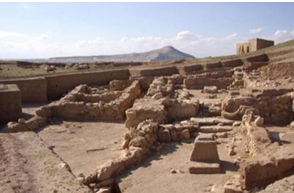(ST)- Akalta City has been proud as defensive fortresses against Hittites, Assyrians and Egyptians during the period of the conflict between these three forces for control of the ancient world in the second half of the second millennium BC. After that conflict the city prospered, expanded and made her huge new walls with an arched gate leading out of the city.
Since 1969, the archaeological mission of the German Oriental Society, conducts the excavation works of the site. In Al Raqqa Museum, there is a showroom specialized to display the discoveries in this site.
The city is located on the east bank of the Euphrates River at the end of Al -Assad Lake on an area of 100 km west of Raqqa city, and 50 km far from the Euphrates dam. The city passed in two phases: the phase of the third millennium BC, and the phase of the second millennium 1500-1150 BC.
The appearance of the layers of fires indicate that the city was destroyed more than once, and the last destruction was about the year1250 BC, where it was abandoned completely, but some finds date back to the Roman and Byzantine periods suggest that the site was inhabited by scattered groups through that period.
Archaeological discoveries on a number of cuneiform tablets talked about the city and its relations with neighboring cities and the existence of two large temples and dwellings as well as the presence of an important wall dates back to the early Bronze Age, with a width of six meters.
Archaeological excavations showed that the residents of Akalta had some handicrafts and practiced various types of agricultural and commercial business, and the city’s commercial market was large in which different trade exchanges were conducted, animals and all kinds of grains, vegetables and fruits also were sold. The animal elephant was present in the region during the second millennium BC, as well as lions, tigers and leopards.
Sh. Kh.

